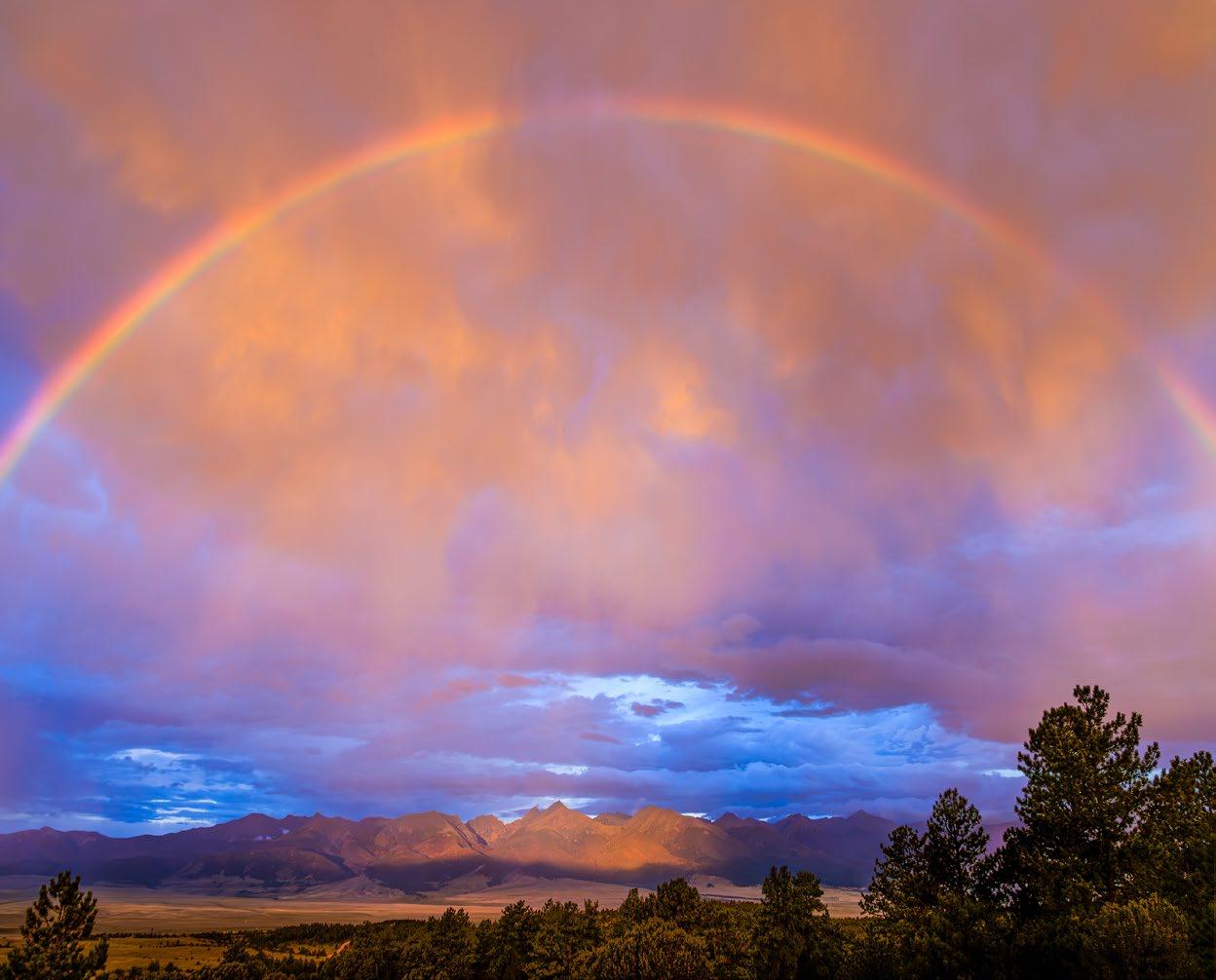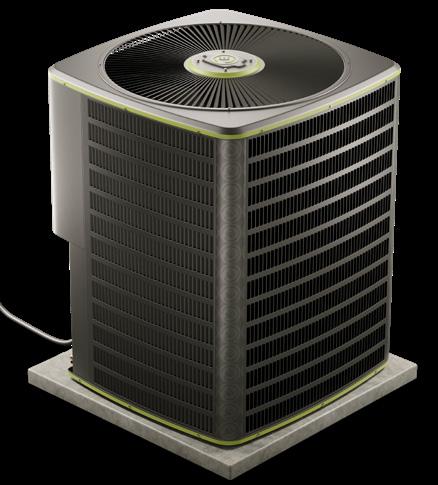










By Kent Singer Executive Director
The recent wildfires in California are a heartbreaking reminder of the risks that face many communities in the arid western United States. While a combination of drought, high winds, and low humidity all conspired to create the conditions for this tragic event, it’s not clear yet who or what was responsible for igniting the fires. It has been suggested that electric utility facilities may have been the cause of at least one of the wildfires, although that has not been proven.

thousands of miles of power lines across the state, many of which traverse remote forests and public lands, it is impossible to mitigate all the risks.
Whether or not the Southern California wildfires were caused by electric power lines, there is no doubt that utility facilities have previously been the cause of wildfires in California. Colorado’s electric co-ops are very much aware of these risks, and they do everything in their power to reduce the possibility that their facilities will cause a wildfire. Electric co-ops go to great lengths to clear vegetation from around their power lines and other facilities, and they are leaders in deploying new technology to anticipate and detect conditions where wildfires may be more likely.
Colorado’s electric co-ops also prepare wildfire mitigation plans that spell out in detail all the steps they take to lower the risks of wildfires. But even the most comprehensive wildfire mitigation plan does not guarantee safety. With
For that reason, CREA has been working on a legislative proposal that would recognize the work being done by Colorado’s electric co-ops around wildfire mitigation. The bill would provide some measure of liability protection for those co-ops that have implemented a state-approved wildfire mitigation plan. Without a bill like this, it may become impossible for Colorado co-ops to obtain adequate liability insurance to protect their consumer-members. Other states have passed similar legislation, and we’re hopeful that the Colorado legislature will consider this bill — if not this year, then in the 2026 session of the legislature.
Colorado’s electric co-ops need reassurance that if they do everything that is reasonably possible to mitigate the risk that their facilities will cause a wildfire, they will not be subject to lawsuits that could literally bankrupt them. Co-ops will always do everything in their power to protect the communities they serve, including investing time and money in measures to reduce the risk of wildfires.
Kent Singer is the executive director of CREA and offers a statewide perspective on issues affecting electric cooperatives. CREA is the trade association for 21 Colorado electric distribution co-ops and one power supply co-op.

February is the month we all need a little pep talk and hope; winter won’t last much longer! Last week, my friend who lives in Gunnison shared on Facebook a photo of her car thermometer showing minus 20 degrees. I think we can all agree that is too cold, but such is wintering in the Rocky Mountains.
As I write this column, Colorado is expecting an Arctic blast. Weather professionals predict subzero temperatures and urge everyone to stay indoors and avoid travel. I will happily heed those warnings; you’ll find me tucked under a few blankets feeling grateful for my warm house.
Essential workers — including your local electric co-op’s lineworkers — don’t always get to stay inside during a deep freeze. Winter’s wind, ice, and heavy snow can increase the potential for power outages, and co-op crews are ready 24/7 to restore power to your home and community.

By Kylee Coleman Editor
In the event of a power outage, your local electric co-op’s team of dedicated staff will work safely to get your electricity back up and running — even during an Arctic blast. Let’s all remember to extend kindness and patience to the people who are working to keep us comfortable inside.

Cassi Gloe, CCC, Publisher cgloe@coloradocountrylife.org
Kylee Coleman, Editor kcoleman@coloradocountrylife.org
Melinda Taylor, Editorial Assistant mtaylor@coloradocountrylife.org
SUBSCRIBERS
Report change of address to your local cooperative. Do not send change of address to Colorado Country Life. Cost of subscription for members of participating electric cooperatives is 30 cents per month, paid from equity accruing to the member. For nonmembers, a subscription is $15 per year in state/$20 out of state.
advertising@coloradocountrylife.org 720-407-0712
National advertising representative American MainStreet Publications 611 S. Congress St., Suite 504 Austin, TX 78704 | 800-626-1181
Advertising Standards
Publication of an advertisement in Colorado Country Life does not imply endorsement by any Colorado rural electric cooperative or the Colorado Rural Electric Association. Colorado Country Life (USPS 469-400/ISSN 1090-2503) is published monthly by Colorado Rural Electric Association, 5400 Washington St. Denver, CO 80216-1731. Periodical postage paid at Denver, Colorado. ©Copyright 2025, Colorado Rural Electric Association. Call for reprint rights. View advertising and editorial policy terms and conditions online at coloradocountrylife.coop/legal.
Denver Corporate Office 5400 Washington St. Denver, CO 80216 info@coloradocountrylife.org 303-455-4111
Editorial opinions published in Colorado Country Life magazine shall pertain to issues affecting rural electric cooperatives, rural communities, and citizens. The opinion of CREA is not necessarily that of any particular cooperative or individual.

by Josh Dellinger General Manager
Empire Electric Association’s 2025 annual member meeting is scheduled for Thursday, June 19, at EEA’s Engineering and Operations Center, which is located at 23999 Road L.4, Cortez, Colorado. Registration will begin at 4:30 p.m. and the meeting will begin at 5:30 p.m. This will be a business meeting only. Members who attend will get $10 credit on their electric bill.

The EEA Board considered present board district composition at its December 2024 meeting and determined no changes to board district boundaries are needed at this time. As of December 2024, the district with the most members had 1,964; the district with the least members had 1,880; and the average number of members per district was 1,930.
There are two board seats up for election this year: District 1 (Jerry Fetterman, incumbent) and District 2 (Bob Barry, incumbent).

The winning candidates will serve a four-year term. In order to serve on EEA’s seven-member board of directors, the cooperative’s bylaws require the following qualifications. The director shall:
• Be a member of the cooperative for at least one year immediately prior to becoming a director.
• Be a bona fide resident of the district represented for at least 120 days prior to becoming a director, which means that the person must be a permanent occupant receiving electric service from the cooperative at his or her primary residential abode.
• Be a citizen of the United States of America and a registered voter in the person’s director district.
• Be at least 18 years of age.
• Not be an employee of the cooperative.
• Complete campaign contributions reports in accordance with Policy 31 – Campaign Contributions Reporting.
Empire Electric Association’s primary mission is to safely, responsibly and reliably meet the electrical energy needs of our member-owners.
Office Hours: Monday – Thursday – 7:30 a.m. to 5:30 p.m. Friday – 7:30 a.m. to 11:30 a.m
801 N. Broadway P.O. Box K Cortez, CO 81321 phone 970-565-4444 toll free 800-709-3726 pay by phone 833-923-1409
eea.coop Facebook.com/EEACortez @eeacortez

EEA Board Districts 1 and 2 seats are up for election this year. If you are interested in running, you can find more information at eea.coop/ your-annual-meeting or call at 970-565-4444 and ask to speak with Shawna McLaughlin.
Generally, District 1 is the west-central portion of the system including Yellow Jacket, Lewis, Arriola, and the southern half of Pleasant View. The eastern boundary begins at the intersection of Road M and the mid-line of T36N R15W S08, and follows this mid-line north to County Road 28. The boundary then follows County Road 28 north until the road’s end, and then follows township and range section mid-lines (starting with T37N R15W S29) north until it intersects with the southern edge of T39N R15W. The boundary then traverses west along the edge between T38N R15W and T39N R15W and continues to follow sequential township and range boundaries west until it intersects the western edge of the service area (much of this route is coincident with County Road CC). The boundary then follows the service area boundary south until it intersects the southwest corner of T38S R26E. The boundary then follows the southern edge of T38S R26E east until it intersects with T37N R20W S27, where it travels north along the western edge of T37N R20W S27, and then travels east along the northern edge of T37N R20W S27, and continues east following the section boundary lines until it intersects with Road S. Then the boundary follows County Road S east to the intersection with Road 21,
then south along County Road 21 until it intersects with Road N, then east along County Road N until it intersects Road 25. From there the boundary follows Road 25 south to its intersection with Road M, and then follows County Road M to the point of beginning.
District 2 is generally the northwest portion of the service area, including Monticello, Dove Creek, Cahone, and the northern half of Pleasant View. The eastern boundary begins at the southern midpoint edge of T39N R15W S32, and generally follows section mid-lines north until it intersects with the northern edge of the service area. From there the district boundary traverses counterclockwise around the northern and western boundaries of the service area until it intersects the northern edge of T37S R26E. From there the district boundary generally follows the northern edges of sequential township and range boundaries east to the point of beginning (much of this route is coincident with County Road CC).
Candidates may be nominated by petition only and such petitions must include the signatures of at least 15 members of the cooperative whose bona fide residences are within the candidate’s district. Qualifying candidates may pick up a nominating petition from our main office during normal business hours. Petitions will be available beginning on March 21, 2025, and must be submitted to EEA by April 21, 2025. EEA staff will post a list of qualifying nominees in our main office at the end of the workday on April 22, 2025.
Each member of the cooperative is entitled to one vote on all issues properly brought before the membership, including the election of directors. Members may vote either in-person at the annual meeting or through mail-in ballots provided by the cooperative. Mail-in ballots will be mailed to members on or before June 4, 2025. In order to be counted, mail-in ballots shall be received by Survey and Ballot Systems (EEA’s election contractor) no later than 5 p.m. on June 13, 2025. All members are strongly encouraged to vote.
If you have additional questions about this year’s election, annual meeting, or any other cooperative business, please visit our website at eea.coop or give us a call at 970-565-4444. We hope to see you at the meeting!
February 2 — Groundhog Day
February 6 — EEA board meeting: 1:30 p.m. at headquarters in Cortez. This meeting is earlier in the month and later in the day than typically scheduled. The agenda is posted 10 days in advance of the meeting at eea. coop. Members may attend in person or remotely. Instructions to attend remotely are included on the agenda.
February 14 — Valentine’s Day
February 15 — Scholarship Applications Due
February 17 — President’s Day

ENERGY EFFICIENCY TIP OF THE MONTH
Safety Tip
Learn how to open your powered garage door manually after a power outage. Refer to manufacturer’s instructions and teach other drivers and older kids in your home how to operate an electric garage door during a power outage.
If you have a home office, look for opportunities to save energy in your workspace. Use ENERGY STAR®-rated equipment, which consumes up to 50% less energy than standard models. Set equipment like printers and scanners to automatically switch to sleep or energy-saver mode when not in use. In addition to saving energy, the equipment will stay cooler, which will help extend its life. Another way to save energy in your home office is to use efficient lamps for task lighting. Replace any older bulbs with energy-saving LEDs.
Source: energy.gov
Thinking of getting a heat pump?
EEA has rebates for units that meet EnergyStar Version 6.1 standards.
• 1.5 ton and smaller air source systems qualify for $500/system.
• Air source systems larger than 1.5 tons qualify for $1,500/system. We also have rebates for ground source and air to water systems.
by Andy Carter Member Engagement Manager
Heat pumps are a great choice to heat and cool your home. They are less costly to operate than electric resistance heaters because the energy is used to move heat instead of creating it. Heat pumps get their name because they use the refrigeration cycle to “pump heat” from outside your home to inside your home. Modern cold climate heat pumps can provide your home heat even during subzero temperatures without using a backup heating system.
To keep your heat pump working as efficiently as it can, you need to make sure you are operating and maintaining it correctly. Having a heat pump professional inspect your system each spring and fall can make sure it is ready to run efficiently and save money on your electric bill. Below are tips for cold weather heat pump operation and maintenance that you can take care of during the heating season.
Heat pumps work most efficiently when you set the thermostat at a comfortable temperature and leave it there. Turning the temperature down for a few hours will cause the heat pump to run at maximum output to bring the temperature back up and that typically uses more energy than if the temperature was held constant all day. If you are going to be gone for more than 24 hours, it can be beneficial to lower the temperature setting until you return.
In cold weather it is better to use heat mode instead of auto. In auto, if the temperature happens to rise above the set point limit it will automatically switch to cooling mode to bring the temperature down to the programmed

setting instead. If you are taking advantage of the sunny winter days to heat your home by opening window coverings and allowing the sun to warm your home, you will lose any savings because the heat pump in auto will pump that heat right back outside.
The type of heat pump system you have will dictate the filter maintenance schedule. Consult your owner’s manual or manufacturer’s website for frequency to clean or replace filters. Keeping filters clean will allow the heat pump to work more efficiently and can also improve the air quality in your home. Ductless systems typically have filters on each indoor unit that can be cleaned and replaced. Ducted systems typically have one large filter for the entire air handling system and are replaceable.
For air source heat pumps it is important to make sure the outside unit has unrestricted air flow. You should visually inspect the outdoor unit once every month to make sure air flow is not obstructed. Verify the unit’s defrost function is working properly and there is not a buildup of ice. Check more frequently if we are experiencing snowstorms and windy conditions.
Remember when…
Think about the things you loved to do that are dif cult today — going for a walk or just sitting comfortably while reading a book. And remember the last time you got a great night’s sleep?
As we get older, health issues or even everyday aches, pains and stress can prevent us from enjoying life.
So what’s keeping you from having a better quality of life?
Check all the conditions that apply to you.
Arthritis Dry Skin
Insomnia Anxiety
Diabetes Mobility Issues
Lower Back Poor Pain Circulation
Then read on to learn how a Safe Step Walk-In Tub can help. Feel better, sleep better, live better
A Safe Step Walk-In Tub lets you indulge in a warm, relaxing bath that can help relieve life’s aches, pains and worries.











A Safe Step Tub can help increase mobility, boost energy and improve sleep.

It’s got everything you should look for in a walk-in tub:
• Heated Seat – Providing soothing warmth from start to nish.
• MicroSoothe® Air Therapy System – helps oxygenate and soften skin while offering therapeutic bene ts.
• Pain-relieving therapy – Hydro massage jets target sore muscles and joints.
• Safety features – Low step-in, grab bars and more can help you bathe safely and maintain your independence.
• Free Safety Package




By Dennis E. Smith
It’s a gloomy winter day in the Colorado foothills, but it’s pretty cozy down here in the basement by the fireplace where I’m tying flies and searching Google to find out how ducks and geese can dangle their feet in bitter cold water all day, or roost on a frozen lake overnight, without their toes falling off. It seems like something we should all know, but not many of us do. Every now and then I’ll jog upstairs to check on the venison jerky I have curing in the oven. I have another batch drying in an electric food dehydrator I borrowed from my son. It’s a handy gadget, but jerky takes time, and if you’re the type who gets antsy waiting for a three-minute bag of corn to pop in the microwave, waiting a couple of hours for a rack of jerky to cure in one of these things can really test your patience. However, paying the equivalent of $30 per pound at the convenience store for an 8-ounce bag of dried meat chips will definitely make the wait seem worthwhile. Making jerky is actually a simple process, or rather it used to be. Primitive hunter-gatherers carved strips of meat from their prey and hung them on bushes in the sun to cure. End of story. But it’s man’s nature to improve everything, so over time wet and dry brines, marinades, herbs, spices, and so on were added to the process. You can whip up your own concoctions at home using common ingredients or buy ready-made
mixes at specialty stores. Regardless, there are probably as many flavors of jerky as there are people who make it. Basic recipes call for some combination of salt, sugar, and maybe liquid smoke to which you might add Worcestershire or soy sauce, honey, molasses, onion and garlic powders, a variety of spices, and peppers. Smoking adds even more curative properties and flavors.
Most agree that removing as much fat as possible from the meat is essential and that slicing the meat with the grain rather than across it produces a better chew, but that’s a matter of personal preference. How to long to brine or marinate can vary from a few minutes to overnight.
When brining is complete, move the meat to a smoker, dehydrator, or kitchen oven to cure. Low and slow is recommended. Then you wait — and watch — for the perfect combination of taste, texture, consistency, and a characteristic some call “snackability.” Jerky should be flavorful and easy to chew without being brittle, gummy, or crumbly. Making a batch is just the sort of thing to do on a gloomy winter day while you’re tying flies and wondering how geese can roost overnight on a frozen lake without freezing their feet off.
Dennis Smith is a freelance outdoors writer and photographer whose work appears nationally. He lives in Loveland.



































By Kim Graber

Think about how often you interact with a digital service every day, whether that’s asking Siri for directions to an appointment, taking pictures with your phone, or sitting down to stream the latest season of The Great British Baking Show. We take for granted that these services will be available when we need them. And typically, they are, thanks to data centers — facilities that power our data-centric lives.
Data centers are facilities that house networks of servers. These high-tech hubs provide data storage and processing power. They store the websites we visit and the movies we watch, and they contain the information technology infrastructure and operations for all of the digital services we use.
“Every time we’re on a Zoom call, there’s data going between our computer and some big gray building in the middle of a field somewhere,” said Mark Dyson, managing director for RMI, an organization focused on clean energy headquartered in Colorado.
“Every time you pick up your phone or type a key on your computer, there’s probably an interaction with a data center.”
Estimates vary when it comes to the number of data centers operating today. Cloudscene, a platform for procuring network services, lists more than 2,000 data centers across the United States, ranging from localized, small-scale centers to massive facilities.
While you’ll find data centers spread out across the country, they’re especially concentrated in a few areas, including the East Coast and California. Colorado currently has about 55 of them — with most of those in metro Denver, according to another industr y database.
Some businesses own and operate their own data centers to provide the processing and storage they need. Others might rent server space from other companies in what’s known as a co-located data center.
Because they’re providing resources to power computing and storage needs for different companies and services, data centers operate around the clock. This means that they require 24/7 power — and lots of it.
“Once some of the biggest data centers that are starting to be built right now are fully up and running, they will consume more electricity than


Every time you pick up your phone or type a key on your computer, there’s probably an interaction with a data center.”
— Mark Dyson, managing director for RMI
in Colorado
the city of Denver, in just a few buildings on one campus,” Dyson said.
Data centers consume this level of power because of three primary systems. First is the computing hardware itself. The servers and networking equipment require electricity to operate.
The second system is temperature control. Running servers generates substantial heat, and the servers must be cooled so they don’t overheat. Management consulting firm McKinsey estimates that facility cooling accounts for about 40% of the energy a data center consumes.
And finally, power is required for the ancillary systems, such as lighting and security, that are needed to operate any sort of facility.
Data centers were already prevalent because of the many ways we use data in modern life. But demand for them is rising even faster to support artificial intelligence-based services. AI requires exponentially more computing power than ordinary processing.
As our demand for data-based services continues to grow, the need for more of these facilities will grow with it. In fact, according
to the Electric Power Research Institute, data centers represent one of the fastest growing industries in the world. Researchers predict that the number of data centers in operation worldwide will grow to more than 8,300 by 2030
And as the number of data centers grows, their energy consumption is likely to grow, too. Investment bank Goldman Sachs reported last year that data centers accounted for 1%–2% of the power consumed worldwide. They estimated this share could grow to 3%–4% by 2030.
But Dyson points out that any actual rise in power usage will depend heavily on other factors beyond the number of data centers. For example, improving energy efficiency could help balance out the growing demand.
Data centers essentially form the backbone of everything we do or interact with online. Understanding their role gives us insight into the technology we use on a daily basis. As we expand our own reliance on digital services, and as companies continue to develop AI technology, data centers are poised to become an even bigger part of our lives.
Kim Graber is a freelance writer based in Longmont.

CCL’s annual photo contest is a chance for readers to showcase their best photography. This year’s theme was Home Sweet Home Colorado, and we received countless entries — it was a joy to see how readers interpreted the four different categories to represent the state we all love to call home. We hope you’ll enjoy this year’s winning photos. You can view these photos and the runners-up on our Facebook page



1.
2.
3.











Recipe courtesy of Uncorked Kitchen
1 avocado, halved lengthwise, pitted, peeled, and cut lengthwise into 1/8-inch slices
3 tbsp fresh lemon juice
¼ English cucumber, peeled, seeded, julienned to length of roll
6 – 8" × 7" sheets nori (seaweed)
3 c prepared sushi rice
1 tbsp wasabi powder, combined with 1 tbsp cold water
4 oz kanikama (imitation) crabmeat sticks
In a small bowl, toss the avocado gently with the lemon juice. Dry roast each sheet of nori over direct heat, holding it at opposite corners with tongs and waving it back and forth over the burner for 30 seconds, or until it turns green.
Lay a dry bamboo sushi mat on a work surface so that the slats run horizontally. Put a piece of the nori on the mat with a long side facing you. With dampened hands, spread ½ cup sushi rice onto it, leaving a 1-inch border along the top edge and ½-inch on bottom. The rice will be on the inside of the roll.
Spread a small bit of the wasabi paste horizontally across the center of the rice — a little goes

a long way for this spicy addition — and top with a cucumber strip. Arrange three avocado slices overlapping slightly in a horizontal line over the wasabi paste and cucumber, then top with one-sixth of the crabmeat.
Grasp the edges of the nori and the mat from the side facing you, lift the nori and the mat slightly, and roll the nori evenly and tightly away from you, pressing down slightly with each quarter turn. Seal the roll with a drop of water on the far edge of the nori, press the seam closed, and transfer the roll to a cutting board. Make five more rolls in the same manner. With a very sharp knife dipped in water, trim the ends of the rolls and cut each roll crosswise into six 1-inch sections, making eight pieces.
ENTER TO WIN

ENTER TO WIN SUPPLIES TO MAKE YOUR OWN SUSHI! Visit coloradocountrylife.coop and enter on our Reader Engagement page. Or send a letter with your name, phone number, and mailing address to CONTESTS 5400 Washington St., Denver, CO 80216.

Half a mile beneath the icy waters off the coast of Argentina lives one of the most remarkable creatures in the world.
Fully grown, they’re less than 2 feet long and weigh under 10 pounds…
But despite their small size, this strange little squid can have a bigger positive impact on your brain health than any other species on the planet.
They are the single richest source of a vital “brain food” that 250 million Americans are starving for, according to a study published in the British Medical Journal.
It’s a safe, natural compound called DHA – one of the building blocks of your brain. It helps children grow their brains significantly bigger during development. And in adults, it protects brain cells from dying as they get older.
Because DHA is so important, lacking enough of it is not only dangerous to your overall health but could be directly related to your brain shrinking with age. With more than 16 million Americans suffering from ageassociated cognitive impairment, it’s clear to a top US doctor that’s where the problem lies.
Regenerative medicine specialist Dr. Al Sears, says thankfully, “there’s still hope for seniors. Getting more of this vital brain food can make a life changing difference for your mental clarity, focus, and memory.”
Dr. Sears, a highly-acclaimed, board-certified doctor— who has published more than 500 studies and written 4 bestselling books — says we should be able to get enough DHA in our diets… but we don’t anymore.
“For thousands of years, fish were a great natural source of DHA. But due to industrial fish farming practices, the fish we eat and the fish oils you see at the store are no longer as nutrientdense as they once were,” he explains.
DHA is backed by hundreds of studies for supporting razor sharp focus, extraordinary mental clarity, and a lightning quick memory… especially in seniors.
So, if you’re struggling with focus, mental clarity, or memory as you get older…
Dr. Sears recommends a different approach.
Research has shown that our paleo ancestors were able to grow bigger and smarter brains by eating foods rich in one ingredient — DHA.
“Our hippocampus thrives off DHA and grows because of it,” explains Dr. Sears. “Without DHA, our brains would shrink, and our memories would quickly fade.”
A groundbreaking study from the University of Alberta confirmed this. Animals given a diet rich in DHA saw a 29% boost in their hippocampus — the part of the brain responsible for learning and memory. As a result, these animals became smarter.
Another study on more than 1,500 seniors found that those whose brains were deficient in DHA had significantly smaller brains — a characteristic of accelerated aging and weakened memory.
Dr. Sears uncovered that sometime during the 1990s, fish farmers stopped giving their animals a natural, DHA-rich diet and began feeding them a diet that was 70% vegetarian.
“It became expensive for farmers to feed fish what they’d eat in the wild,” explains Dr. Sears. “But in order to produce DHA, fish need to eat a natural, marine diet, like the one they’d eat in the wild.”
“Since fish farmers are depriving these animals of their natural diet, DHA is almost nonexistent in the oils they produce.”
“And since more than 80% of fish oil comes from farms, it’s no wonder the country is experiencing a memory crisis. Most people’s brains are shrinking and they don’t even know it.”
So, what can people do to improve their memory and brain function in the most effective way possible?

MEMORY-RESTORING SENSATION: The memory-saving oil in this Antarctic squid restores decades of lost brain power starting in just 24 hours.
Dr. Sears says, “Find a quality DHA supplement that doesn’t come from a farmed source. That will protect your brain cells and the functions they serve well into old age.”
Dr. Sears and his team worked tirelessly for over 2 years developing a unique brainboosting formula called Omega Rejuvenol
It’s made from the most powerful source of DHA in the ocean, squid and krill — two species that cannot be farmed.
According to Dr. Sears, these are the purest and most potent sources of DHA in the world, because they haven’t been tampered with. “Omega Rejuvenol is sourced from the most sustainable fishery in Antarctica. You won’t find this oil in any stores.”
Already, the formula has sold more than 850,000 bottles. And for a good reason, too. Satisfied customers can’t stop raving about the memory-boosting benefits of quality-sourced DHA oil.
“The first time I took it, I was amazed. The brain fog I struggled with for years was gone within 24 hours. The next day, I woke up with the energy and mental clarity of a new man,” says Owen R.
“I remember what it was like before I started taking Omega Rejuvenol… the lack of focus… the dull moods… the slippery memory… but now my mind is as clear as it’s ever been,” says Estelle H.
“My mood and focus are at an all-time high. I’ve always had trouble concentrating, and now I think I know why,” raves Bernice J.“The difference that Omega Rejuvenol makes couldn’t be more noticeable.”
And 70-year-old Mark K. says, “My focus and memory are back to age-30 levels.”
These are just a handful of the thousands of reviews Dr. Sears regularly receives thanks to his breakthrough memory formula, Omega Rejuvenol
WHERE TO FIND OMEGA REJUVENOL
To secure bottles of this brainbooster, buyers should contact the Sears Health Hotline at 1-800-966-2267. “It takes time to manufacture these bottles,” says Dr. Sears. “The Hotline allows us to ship the product directly to customers who need it most.”
Dr. Sears feels so strongly about this product, he is offering a 100%, money-back guarantee on every order. “Send back any used or unused bottles within 90 days and I’ll rush you a refund,” says Dr. Sears.
The Hotline is taking orders for the next 48 hours. After that, the phone number may be shut down to allow for inventory restocking. Call 1-800-966-2267 to secure your limited supply of Omega Rejuvenol. Readers of this publication immediately qualify for a steep discount, but supplies are limited. To take advantage of this great offer use Promo Code COOM225 when you call.

Barbara Humbracht, a member of Empire Electric Association, won the bottle of Free Spirits nonalcoholic bourbon in CCL’s January giveaway.







Colorado is never short on coffee shops. Don’t settle on the common joe-on-the-go found on every corner — visit a unique and local hangout and try something new. We took a sip around and found a few coffee shops that you might want to put on your “best brew” list.

A great cup of coffee is just as much about the roasting process as it is about the beans. But Mike and David Hartkop — owners of Solar Roast Coffee — will tell you that it’s the power of the roaster that really brings out the flavor. Made 20 years ago from an old satellite dish, a bunch of mirrors, a broccoli strainer, and a dream, the world’s only commercial solar coffee roaster was invented by the brothers. Many revisions later, it has evolved into a stateof-the-art modern marvel that can roast up to 150 pounds of coffee each hour. Solar Roast sells by the cup or the pound in their thriving shops in southern Colorado. To learn more, visit solarroast.com.

Kiln Coffee Bar in Grand Junction is a gathering place to meet with friends, have a good drink, enjoy scintillating conversation, and stay awhile. The coffee bar was one of the first in the area to offer a pour-over. Co-owner David Foster says it is one of Kiln’s most popular options. He says, “When you order a pour-over, you’re able to select a higher quality of bean, which is nice as there’s less acidity overall, and it tends to be a smoother coffee experience.” To learn more about Kiln and its handselected coffee beans, visit kilncoffeebar.com.
By Gaylene Garcia Granger

Founded in 2009 by Crested Butte native Danica Ramgoolam and her husband Arvin, Rumors is a quaint coffeehouse on Elk Street in downtown Crested Butte. When asked about its intriguing name, Danica says, “Our small town can sometimes be a rumor mill, so we thought what better name for a coffee shop than Rumors, where you can get all the latest spin on things.” Indeed, Rumors customers love the local vibe. To learn more, visit Rumors online at rumorscoffeeandteahouse.com.



Joseph and Winnie Vasquez, Mountain View Electric Association members, bring their CCL magazine to Maui, Hawaii, on a trip to celebrate their 42nd anniversary.

de
Association member
enjoys CCL in Jamaica on a recent trip with her sister.

Shelley Prissinotti travels to Puerto Vallarta, Mexico, and brings CCL along for the sun and fun. Shelley is a Mountain View Electric Association

Grand Valley Power members Aspen and Christopher Coombs pause to reflect with CCL outside the Byzantine monastery of Moni Agiou Stefanou, high atop the Meteora rock formations of Greece.
Lynn and Jim Connaway from Grand Junction bring their copy of CCL to Antarctica and snap a photo at Edinburgh Hill. The Connaways are members of Grand Valley Power.

Isabel Electric Association members
and Larry George stop for a photo with the magazine at the Leaning Tower of Pisa during their tour of Tuscany.

members
day
Show us where you enjoy CCL for a chance to win! Take a photo of someone (or a selfie!) with the magazine and share it with us on the Reader Engagement page at coloradocountrylife.coop. Each month we’ll draw one photo to win $25. See all the submitted photos on our Facebook page @COCountryLife




MAXIMIZE YOUR SAVINGS DURING HEATING AND COOLING SEASON
When paired with proper insulation, energy efficient electric heat pumps can save you over 30% on your heating and cooling bills compared to conventional HVAC systems.
LEARN MORE AT: TRISTATE.COOP/ELECTRIFY-AND-SAVE



1Subject to availability, on a total purchase of 4 or more. Buy 2 windows or doors and get the second 2 windows or doors, of equal or lesser value, 50% off – applied to lowest priced window and/or door products in purchase. BOGO 50% off discount valid during first appointment only. Cannot be combined with other offers. To qualify for discount offer, initial contact for an appointment must be made and documented on or before 2/28/25 with the purchase then occurring on or before 3/10/25. *Review aggregator survey of 5-star reviews among leading full-service window replacement companies. January 2024 Reputation.com. Products are marketed, sold and installed (but not manufactured) by Renewal by Andersen retailers, which are independently owned and operated under Window Warmth, LLC d/b/a Renewal by Andersen of Colorado. CO Lic. # 244783. NM Lic. # 399874. See complete information and entity identification at www.rbaguidelines.com. ©2025 Andersen Corporation. ©2025 Lead Surge LLC. All rights reserved. 2Plan 4521. Subject to credit approval. Rates range from 14.26% - 21.19% APR (interest rates range from 15.99% - 24.99%). Loan amount and rate will vary based on your income and creditworthiness. Monthly payments are not required during the Promo Period.